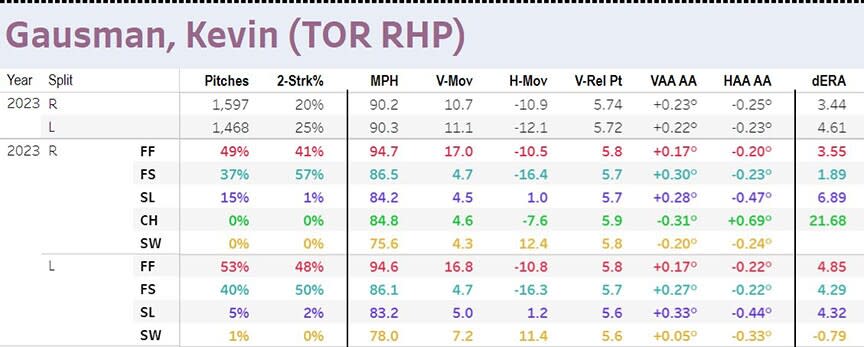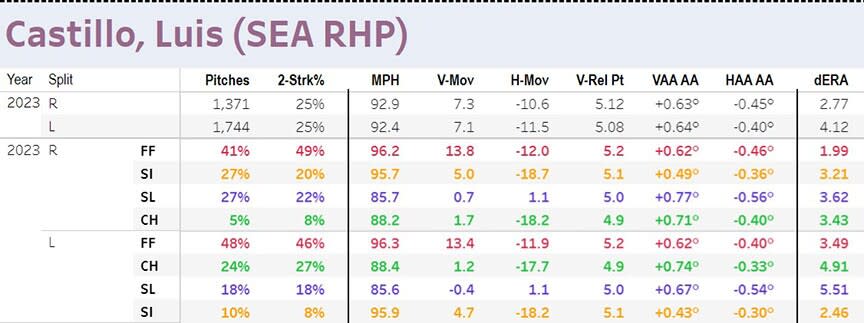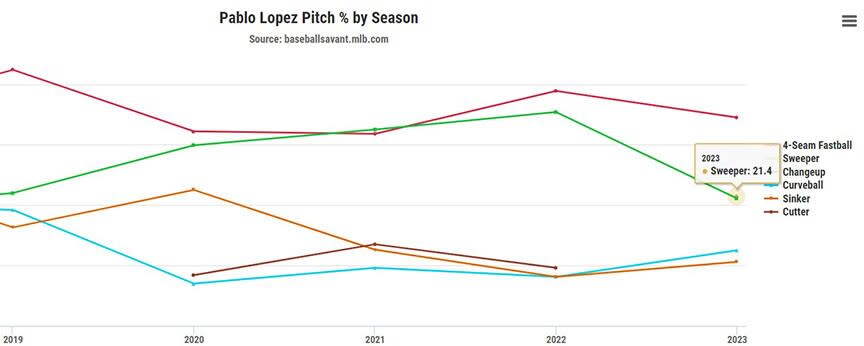Fantasy Baseball SP ADP Battle: Ranking Kevin Gausman, Luis Castillo, Zac Gallen, Pablo Lopez
We're under a month away from pitchers and catchers reporting to spring training, so it's time to begin looking at our fantasy baseball ADP and see how the landscape is shaping up. That means we're going to begin this series called Starting Pitcher ADP Battles where I look at 3-4 starting pitchers who are going right in the same ADP range and breakdown who I feel most confident in and why. The goal here isn't so much to make you agree with me as to help us all together think analytically about these pitchers to make a decision in our drafts that we feel most comfortable with.
Today we're going to look at four starters who are going in the third round of 15-team drafts. These are all guys who you would draft as your SP1 but perhaps only half of them were drafted as such last year, so there is some uncertainty about which direction we should go in. I should note that Nick Pollack from Pitcher List and I also covered these guys on the most recent episode of the On The Corner Podcast, and you can check out that episode in the next few days (we'll tweet it out and it's available wherever you get your podcasts).
So who are the arms and who is my favorite?
All ADP data is taken from NFBC drafts from December 18th through January 18th, which is 97 drafts.
Kevin Gausman - Blue Jays (ADP: 29, SP5)
Kevin Gausman is the first starting pitcher off the board from this crew, and it's not totally surprising since last year he posted a 12-9 record with a 3.16 ERA (3.34 SIERA), 1.18 WHIP, 31.1% strikeout rate, and 23.9% K-BB%. The strikeout rate was the highest of his career (aside from the COVID-shortened 2020 season), and he shaved .042 points off his BABIP. Not to mention, this was his third straight season with 175 innings or more, so he appears to provide a relatively safe innings floor, if such a thing exists.
Knock your draft out of the park with the 2024 Rotoworld Baseball Draft Guide, featuring rankings, projections, expert analysis, mock drafts and much more. Click here to buy now and use code BASEBALL24 for 10% off.
But here's the thing, I just can't take Gausman as the fifth starting pitcher. There are too many red flags for me. Can he be your team's SP1 for fantasy? Sure. He's incredibly unlikely to have a bad season, but I simply am not as confident in him as a couple of the other pitchers on this list.
The first concern for me is that Gausman is essentially a one pitch pitcher. In 2023, Gausman threw his four-seam and splitter 89% of the time. Now, while that may make it seem like he has two pitches, the truth is that the four-seam is not that great. At 94.7 mph, it has league average velocity, and despite having above-average Induced Vertical Break (IVB), Gausman only throws the pitch up in the zone 28.7% of the time, according to Pitcher List metrics. As a result, the four-seam allowed a 12.6% barrel rate in 2023 and a 48.5% ICR (Ideal Contact Rate, which is barrels + solid contact +flares/burners divided by total batted ball events). Those are pretty poor metrics. The pitch also registered just an 8.7% swinging strike rate (SwStr%), so it doesn't miss bats and gives up hard contact but has a 96th-percentile called strike rate since most hitters are looking for his splitter.
There is also clear regression coming for his four-seam, in my opinion. Pitcher List has him down for a 24.4% putaway rate on his four-seam in 2023, which was 95th-percentile. However, he had nearly identical SwStr% and CSW to 2022 and 2021. In 2022, the putaway rate on his four-seam was 17.5% and in 2021 it was 19.6%. So if the pitch has the exact same shape, same SwStr%, same CSW, and similar locations as previous seasons, it would make sense for the putaway rate to fall closer to 20% in 2024, which would cause a dip in his overall strikeout rate.
The reliance on the four-seam to get called strikes also places an awful lot of pressure on one pitch for Gausman to have success. Gausman's splitter did have a 22.2% SwStr%, and 3.18 Defense Independent ERA (dERA) in 2023, but he also threw the pitch in the zone just 21.2% of the time, which is 12th-percentile. So much of the splitter's success is in getting hitters to chase the pitch out of the zone.
Knock your draft out of the park with the 2024 Rotoworld Baseball Draft Guide, featuring rankings, projections, expert analysis, mock drafts and much more. Click here to buy now and use code BASEBALL24 for 10% off.
So what we have is a pitcher with two pitches, one of which routinely gets hit hard and doesn't miss bats and the other that he regularly doesn't throw in the strike zone. That's also part of the reason his BABIPs have been so high over the last two years. He gets batters to chase out of the zone a ton, but when they do put the ball in play, it's usually hit well, which means those balls fall for hits more often. There isn't really an easy cure for his BABIP's, which is why his WHIP will always be a little higher than you want from a top-10 starter.
Oh, and his splitter is also less effective against lefties, which means he has to rely more on his fastball against lefty-heavy lineups, and we already covered above why that might be an issue.

Has this approach worked for him so far? Over the last three seasons, yes, but I'd be lying if I said that didn't scare the hell out of me as the top arm in my rotation.
Luis Castillo - Mariners (ADP: 32, SP6)
Castillo is the first starter on this list that I'd take before Gausman. First off, his surface-level numbers were not much worse, posting a 14-9 record with a 3.34 ERA (3.74 SIERA), 1.10 WHIP, 27.3% strikeout rate and 20.3% K-BB%. While his ERA and strikeout rate were slightly worse than Gausman's, he had a better WHIP and also posted a 14.7% SwStr% compared to Gausman's 12.9%. Plus, I trust Castillo's pitch mix and approach more.
Both he and Gausman have been innings-eaters over the last few seasons, with Castillo pitching at least 150 innings in every full season of his MLB career. That's also part of the reason he's won at least eight games in every full season, including ones in which he pitched for a really poor Reds team.
However, my cause for optimism with Castillo is rooted in his deeper arsenal of pitches. The right-hander has three pitches that have at least a 17.2% SwStr%. He also recently tweaked his arsenal to be more focused on four-seam fastballs and sliders, rather than four-seam and change-up. While that may seem odd to you considering his change-up has long been considered his best pitch, the truth is that it's simply not as good an offering against righties, and Castillo faces drastically more right-handed batters.
Castillo's slider has an 18.8% SwStr% to righties and just a 27.1% ICR, meaning he misses lots of bats and doesn't give up much hard contact. That's why he throws it 27% of the time to righties and 18% of the time to lefties, who post a 13.9% barrel rate against the pitch because he often catches too much of the plate when he throws it down and in to lefties. That was the reason his splits were poor last year, but I think there is room for growth against lefties if he can locate that slider better.

I'm also not as worried about his splits because we just mentioned that Castillo has long been known for his change-up and he's able to use it 24% of the time to lefties, where it registers a 17.9% SwStr%.
He also mixes in a sinker 27% of the time against righties, jamming it inside on the hands 55% of the time, which is part of the reason it induces a 63.5% groundball rate and 46.2% "topped" contact. Using the sinker to righties also allows his four-seam to play up because of his elite vertical approach angle. That's why his four-seam had a 19.6% SwStr% against righties.
All of which is to say that Castillo has a deep enough arsenal to attack hitters of both handedness and an approach that should continue to lead to solid strikeout totals, low WHIPs, and limited hard contact allowed. That just feels like a really safe profile to me. If we believe safety with starting pitchers exists.
Zac Gallen - Diamondbacks (ADP: 38, SP7)
When I started the off-season, I was much higher on Gallen then I find myself right now. I'm willing to be convinced to get back on board, but at this juncture, I have him ranked the lowest of the four names I'll mention today.
Like all the pitchers on this list, his surface-level numbers were strong in 2023 with a 3.47 ERA (3.67 SIERA), 1.12 WHIP, 26% strikeout rate, and 20.4% K-BB%. However, when compared to the other names mentioned here, Gallen had the second-highest ERA, worst strikeout rate, worst SwStr%, worst SIERA, and worst CSW. And now for the part that really concerns me: he also had the worst ICR with a 43.9% rate, which is really bad.
So when you stack him up against these other four arms, Gallen misses the fewest bats and allows the hardest contact in play. That's not a good combination. But let's dive deeper.
Gallen features primarily a four-seam, curve and change, all of which have solid dERA metrics and all of which he throws DOWN in the zone. His four-seam actually has 80th-percentile low location, according to Pitcher List, which is not generally something we like to see, but it works for him because he has above average IVB and extension. The low location also works well with the change-up and curve, since he also keeps both of those pitches low in the zone, which helps him keep hitters off balance. He also started to mix in a slider against righties in the final month of the season last year; although, it was a super small sample size.
But that need to keep hitters off balance is the key for Gallen. All three of his main pitches have ICR's of 40% or higher, including a whopping 47.7% rate on his curveball. He needs to keep them low, and he needs to keep hitters guessing because when they do make contact, they tend to make hard contact.
Now, Gallen is a smart pitcher who understands his arsenal and has done a good job of mixing and matching pitches, which is why he's had consistent success at the MLB level. However, I'm not sure there's much room for growth here unless we see the slider morph into a real offering for him this spring. Without that, you could be looking at 3.50 ERA pitcher with a 26% strikeout rate. That's not bad, but I'm not sure it's a top 10 starter, and if he doesn't reach 200 innings again then his strikeout totals won't help you nearly as much as you'd need them to if you want to draft him as the 7th starter overall.
At the end of the day, I have no issues with Gallen as an SP1 on fantasy teams. I just am a little concerned that he has less margin for error than some of the other arms, so I have him on the fringes of my top-10.
Pablo Lopez - Twins (ADP: 40, SP8)
Now we move to the pitcher I currently have ranked second among the four here. Yes, I have Pablo one spot ahead of Kevin Gausman, and yes that makes me feel a touch uncomfortable.
But here's the thing, Pablo has been really good for four years now and is being penalized for injuries he suffered earlier in his career. He has now made back-to-back 32 start seasons and also pitched 57.1 innings in the COVID-shortened 2020 season, so he's thrown a full season in three of the last four years. Why are we treating him as if he's significantly riskier than any other starter? All starters, especially those who push 180+ innings, are at risk of having an arm injury. There are some pitchers whose velocity of pitch mix will cause them to strain their arms more regularly, but the truth of the matter is that, with so many top arms already injured and out for the year, almost every pitcher outside the top four has more risk than we're used to having with our SP1. Instead of finding reasons to avoid something that is incredibly hard to avoid, like starting pitcher risk, we should be taking calculated risks and drafting pitchers who we know will perform at SP1 standards when on the mound.
That's Pablo Lopez.
In 2023, he posted a 3.66 ERA (3.37 SIERA), 1.15 WHIP, 29.2% strikeout rate, and 23.2% K-BB%. His 14.5% SwStr% is second best of this group, his SIERA is second-best of his group, his K-BB% is second-best, his CSW is the best of this group, and his ICR allowed of 36.1% is also the best of this group. So based on 2023 performance, he was one of the two best arms among these four.
So why do we believe that's unsustainable, other than punishing him for one injured year in the last four?
Lopez' success is also tied to clear changes; one of which being the addition of a sweeper to his repertoire. In 2022, Pablo was 74% four-seam and change-up and then also threw a cutter 10% of the time. In 2023, he ditched the cutter and used the sweeper 21.3% of the time.

The pitch registered a 16.9% SwStr%, 2.59 dERA, 32.5% CSW, and allowed just a 27.7% ICR. While it had a putaway rate of 22.9% (72nd-percentile), he didn't just use it as a strikeout pitch. He actually threw it when he was ahead in the count 58.4% of the time. So it performed as both a strong called strike offering and also a swing-and-miss pitch, which is tremendous.
While Pablo's four-seam isn't elite, he added 1.4 mph and 1 inch of IVB on it, which helped it register a 17.1% SwStr% because he uses it up in the zone 60% of the time. Those velocity gains also happened as a result off offseason work at Driveline, so they can be tied to specific cause and effect and not just a random fluke.
Lastly, Pablo changed the shape of his curve and started throwing it more often in 2023. Since he was using the sweeper both early and late in counts, the new shape of the curve allows it to tunnel better with the sweeper, which led to a jump in SwStr% on the curve to 16.6%. That gave him four pitches with at least a 15.8% SwStr%.
The one weakness I can spot is that the sweeper and four-seam are less effective to lefties, which causes him to rely on the change-up and curve more. While those pitches are solid, it does take away his best offering against lefties, which led to slightly less swing-and-miss and higher dERA and average against. He's still not bad versus lefties, and he does have multiple solid offerings to fall back on, but he may not put up elite pitching lines against lefty-heavy lineups.
Still, given all the changes he made and the success he saw because of those changes, it feels like Pablo is being written off because he battled injuries years ago. We've just outlined major risks with every pitcher in this article except for Castillo, so none of them come without warts. I'd rather take the pitcher who I think is the best bet to pitch at a high level when he's on the mound, and, to me, Pablo has another potential step in his development if he figures out an attack plan against lefties, that I don't see with Gausman and Gallen at this moment.
Eric’s Ranking
For these four pitchers, I have them ranked as follows with their current ranking in my NON-FINALIZED top 100 in parenthesis:
1) Luis Castillo (SP4)
2) Pablo Lopez (SP7)
3) Kevin Gausman (SP8)
4) Zac Gallen (SP11)
See you back here next week for another Starting Pitcher ADP Battle.

